Search results
9 results found.
9 results found.
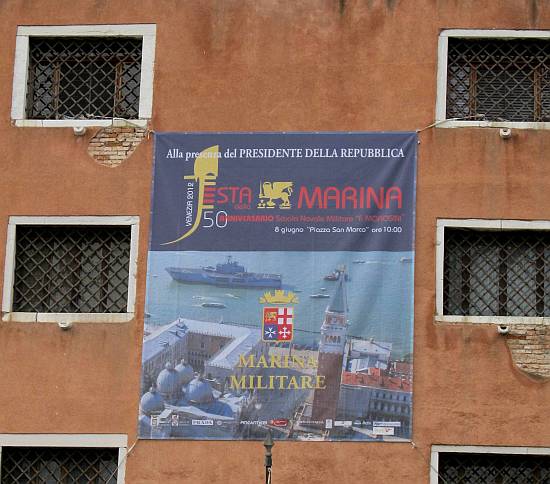
This might shock you, but there was a huge festa here on June 8 that was not attached to any saint, living or dead, as far as I could tell.
I intended to report on this sooner, but what with tornados and all, it’s taken me this long to return to happy thoughts.
It was the Festa della Marina Militare, or Festival of the Navy, and it also happened to be the 50th anniversary of the founding — or re-founding — of the Francesco Morosini Naval School where Lino teaches Venetian rowing. One of the highlights of this event was the swearing-fealty-to-the-flag by the first-year class, which makes them officially members of the Navy with the low but respectable rank of second-class seamen. No joke, they get the same pay as their swabby confreres who aren’t studying chemistry and bird skeletons.

So a vast parade was organized in the Piazza San Marco involving not only the three classes of the school, but virtually every other branch of the armed forces and a regiment of alumni, many of whom showed up in their work clothes, by which I mean uniforms of admirals, generals of the Carabinieri, Guardia di Finanza, Mountain Artillery, Army, Air Force, etc., as well as the dark suits of Senators and Ministers. The Secretary of Defense was here, the Secretary of the Navy was here, and even the President of the Republic was here. It was all far beyond cool. The only person who could have made it any cooler would have been Jean Dujardin. Maybe they sent the invitation to Joan of Arc by mistake.
The weather cooperated (no scorching sun and only a few drops of rain), no cadets dropped to the pavement, and the speeches were only moderately silly and only moderately too long. As usual, the Navy Band played the national anthem about 15 times, not always completely (it seems to act as a sort of aural page-turning cue, like the beep that used to tell your teacher it was time to change the slide). Hearing the national anthem so many times noticeably diminishes its emotional impact. If you’d like to know my opinion. Or even if you wouldn’t.
It was a great event and I’m glad I was there. I doubt I’ll be able to make it interesting to my grandchildren, but I’ll enjoy looking back on it.


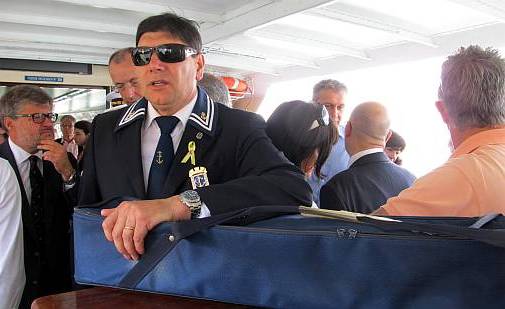
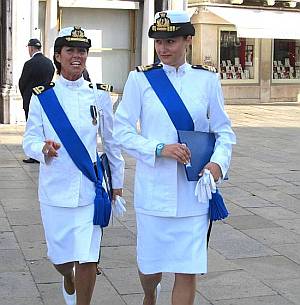
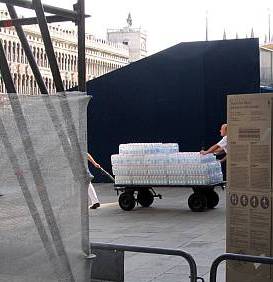


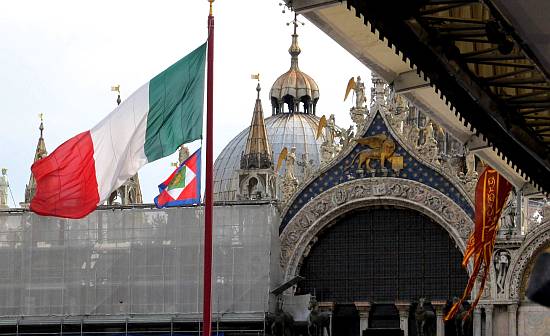
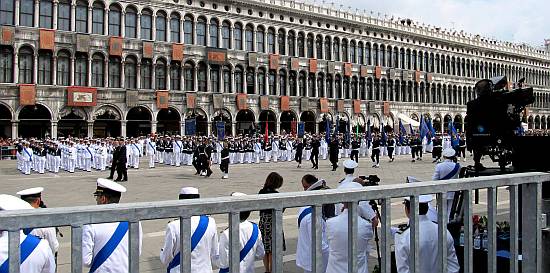
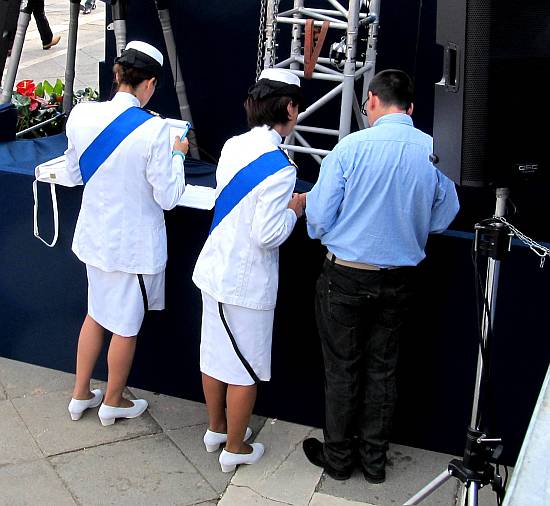


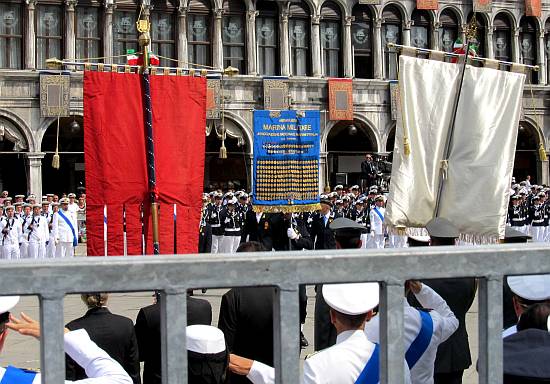
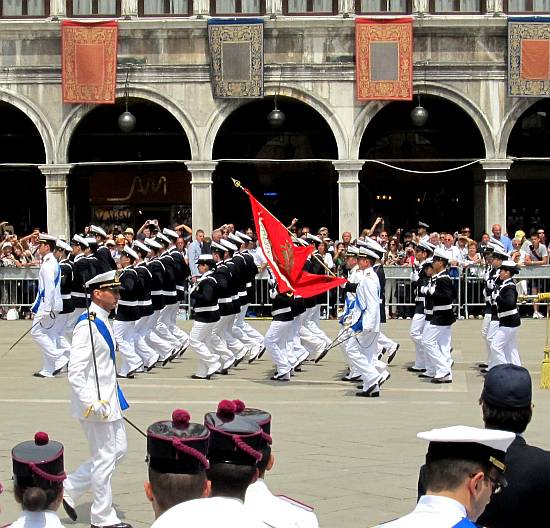
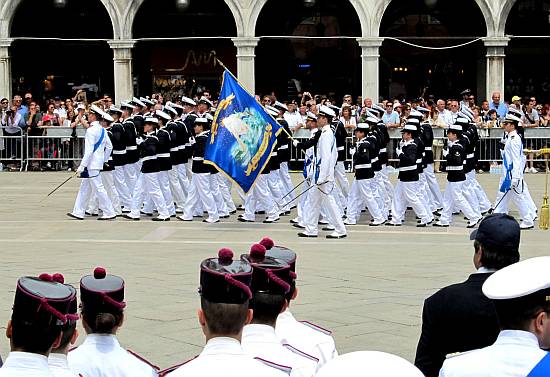

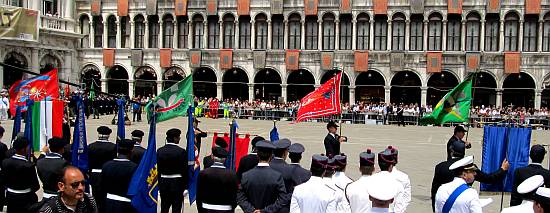


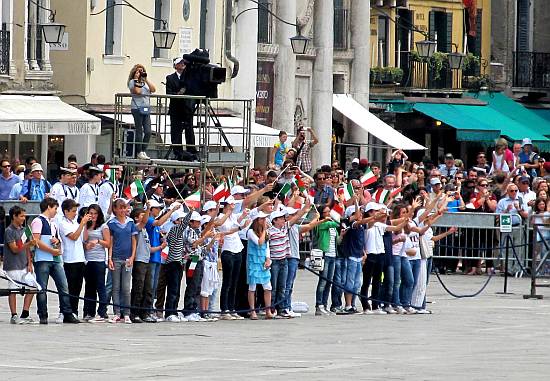
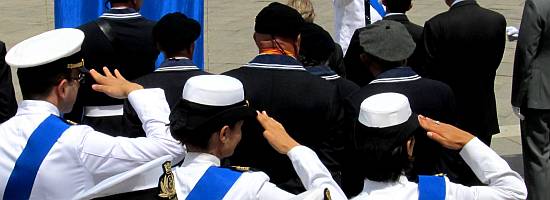
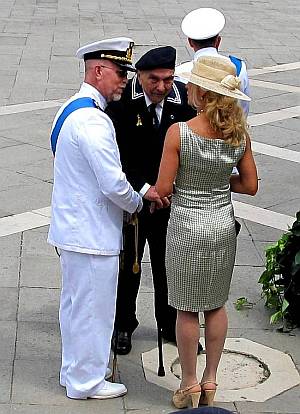
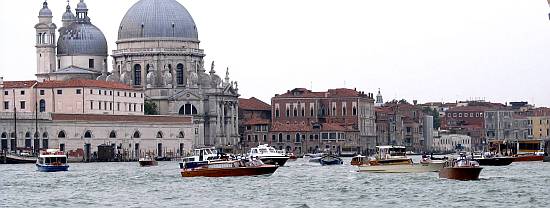
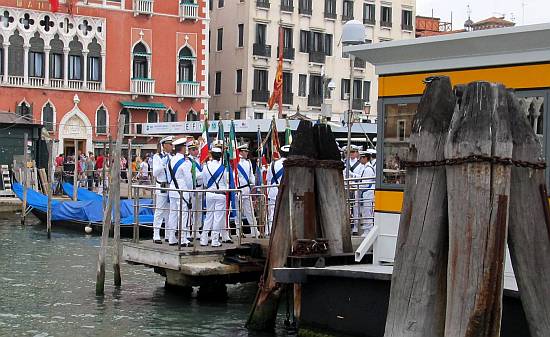
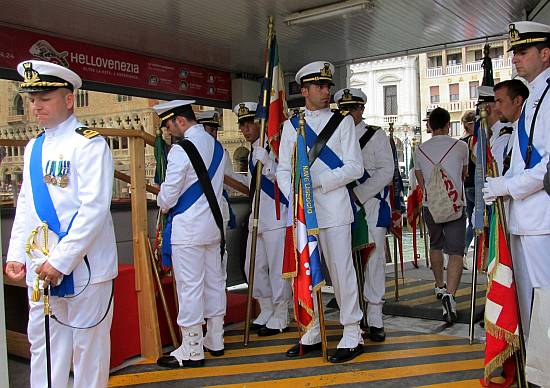
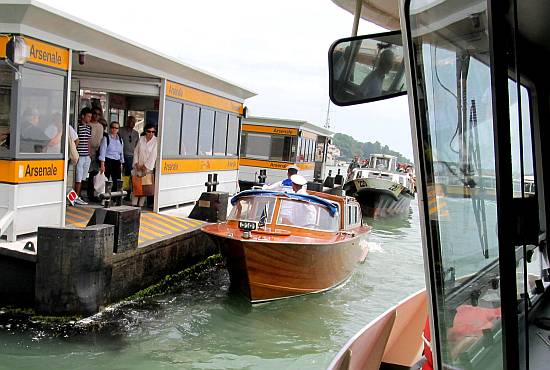
A tornado crossed part of the lagoon yesterday morning, and part of Sant’ Elena was in its way, And all of our boat club.
The office is gone, the two buildings and sheds where our boats were kept are gone. And the boats are pretty much gone, too. I don’t mean “gone” as in lifted to heaven in the rapture, I mean it in the sense of smashed to various bits. Because we were in a phase of demolishing the old clubhouse in anticipation of a new facility and all our 34 boats were outside.
The man who operates the winch to put the boats in and out of the water was in the metal container that served as his temporary shelter at the water’s edge. The tornado rolled it over a couple of times with him in it, and two men managed to get him out. He was rushed to the emergency room with a gash in his head and two broken ribs, but at least the container wasn’t tornado’d into the water with him in it.
Trees snapped and uprooted, but no further victims, as far as I know, unlike the previous tornado in 1970.
When the tornado struck, we were at the Rialto market where our attention was mostly dedicated to the price of cherries. It rained, but we had not even the slightest hint that devastation was being wrought just over the way. We had a blast of rain, but there wasn’t anything about it that made you think of anything worse than your wet feet.
We got the news from a friend who was at San Marco, and who had seen it. Then the phone calls began to spread the word. At that point I was on Murano with a friend, so I wasn’t able to go help with the first load of work, But Lino was there all afternoon, along with almost every club member who was available.
I’m still trying to get a grip on all this. Because this morning has dawned cool, clear, and dazzling with cloudless sunshine. Translation: The perfect day to go out in a boat.
The website of the Remiera Casteo has photographs and film of what the tornado left behind.
YouTube has a number of clips of this event but here is one of the best. If the video isn’t shown, here is the link: http://youtu.be/KFCaI_L_K4s
This, as everyone knows, is a very heavy date in the periodic table of tragedy. The year 2001 will be scarred forever by the events of that day.
In Venice, September 11, 1970 was also a day of cataclysm, but it was a tornado, rather than any manmade phenomenon, which dealt the blow.
Tornadoes are not uncommon in Italy, which stands sixth in the European ranking with an average of 12-18 a year. And that evening, a grade F4 tornado rose up in the countryside beyond Padova.
A grade F4 tornado, according to the Fujita-Pearson Tornado Intensity Scale, will bring winds between 207-260 miles per hour (333-418 km/h). The standard description of the effect at that level is “Devastating damage. Well-constructed houses leveled; structures with weak foundations blown away some distance; cars thrown and large missiles generated.”
In a country not unacquainted with natural disasters — the eruption of Vesuvius, the Messina earthquake, etc. — this stands out as one of the worst tornadoes ever to strike Italy, surpassed only by the F5 “tromba del Montello” of 1930.

According to the Gazzettino, it went like this:
At 8:45 PM a tromba d’aria, or tornado, forms in the Euganean Hills between Teolo and Revolon, about 39 miles (63 km) from Venice. It zigzags eastward, sowing destruction which I won’t list here but which leaves 300 houses damaged or destroyed and many people injured. Night has fallen.
At 9:32 PM the tornado reaches the lagoon. It rips tiles off the hospital roof on the island of La Grazia, then heads toward the Bacino of San Marco.

At 9:35 it strikes the 400-ton lagoon passenger ferry “Aquileia,” twisting and contorting the superstructure and hurling all the passengers to the floor. “A powerful depression took our breath away,” one passenger told the Gazzettino, “the captain of the motonave blew the horn three times as a signal of danger, and then all at once…all the doors and windows of the cabins at the bow and the stern were blown to bits.” One person is injured.
At 9:36, the tornado turns toward the island of Sant’ Elena, the furthest eastern lobe of the city of Venice. And there it finds a 20-ton vaporetto, motoscafo “130,” carrying about 50 passengers toward the Lido. The waves are tremendous and the wind even more so; the motoscafo, which has slowed down to stop and tie up at the dock at Sant’ Elena, rolls once to starboard, once to port, then keeps going over, taking on water and sinking in seconds. Twenty-one people are trapped inside and drown. Later it is discovered that the vaporetto, capable of carrying 143 passengers, had only five lifejackets. From survivor accounts, though, it’s not clear to me how much the lifejackets would have helped.
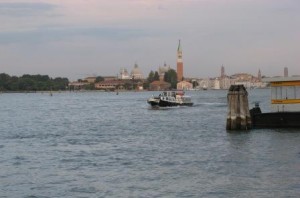
“It was a matter of just a few seconds,” the captain said; “the motoscafo lifted itself and then capsized, something incredible. When I found myself in the water I tried to help the people nearest to me, but it was dark and I saw very few.”
A woman recalls, “The boat rocked once or twice, then all the lights went out and I was thrown from one side to another; I heard a noise of glass breaking and water came flooding in…a current pulled me along and I felt with my fingers an open window and I was able to slip through it. When I reached the surface, there were people screaming and lifeless bodies. I managed to reach the dock and somebody pulled me out.”
“A powerful wind took my breath away,” another survivor said, “and I was thrown into the water, losing my glasses. Terrified, I managed to grab a piece of floating wood and swimming with one arm I was able to reach the Morosini Naval College, where the cadets helped me. I heard many screams around me but I couldn’t see anything.”
At 9:37, one minute after striking the vaporetto, the tornado crosses Sant’ Elena itself. Poplars and pines are uprooted, roofs torn off houses, part of the vaporetto dock is ripped away and thrown 650 feet (200 meters). The soccer stadium partially collapses, pieces flying everywhere.
It keeps moving toward the littoral near the inlet to the lagoon at San Nicolo, wreaking havoc on the peninsula of farms and beach villages around Punta Sabbioni, Ca’ Savio, and Cavallino. And then it is gone.
At 10:00 the rescue divers arrive, and work until midnight in 9 feet (3 meters) of water to recover the bodies from the sunken vessel.
The tornado lasted 58 minutes, traveled 43 miles (70 km) at an average speed of 44 mph (72 km/h), with winds at least of 136 mph (220 km/h). It left 36 victims and some 3.7 million dollars (2.5 million euros) in damage.

The Gazzettino reported the scene it left behind at Sant’ Elena:
“The neighborhood is unrecognizable; streets are covered with bricks, windows blown out, and boats thrown around.
“The ticket booth (for the vaporetto) was thrown 50 meters (164 feet) away, crumpled against a house.
“What had been a pine grove was a mass of broken tree trunks, a tangle of branches, panels, and electric wires.
“Many roofs are torn apart, leaving only the beams, the rooftiles are strewn in heaps on the ground, along with the wreckage of chimneys, beams and doors which you can’t understand where they came from.
“Near the stadium a garden wall has been destroyed but the debris has disappeared, sucked away by the tornado; the earth has been lifted in banks, it seems as if you’re walking in a plowed field.”
Lino was out fishing that afternoon and everything was normal. He went home and was having dinner with his wife and six-year-old son, Marco, when they started to hear thunder.
“It was strange thunder,” he told me, “one after another, and it just kept going.” The three of them went out to the nearby Fondamenta degli Incurabili and looked west toward the mainland.
“The sky was unbelievable,” he said. “It was more spectacular than the fireworks at Redentore, lightning and thunder that never stopped. Then one or two drops of rain fell and I said,’Let’s go home.'”
The next morning he was shaving when his downstairs neighbor called. “Did you hear the news on the radio?” he asked. Lino hadn’t. Nor had he even heard the passage of this wind from hell, which evidently cleaves its path with more precision than a diamond-cutter.
“There’s been a tremendous disaster at Sant’ Elena — a motoscafo has capsized and there’s all kinds of victims.”
Stunned but naturally curious, Lino took Marco and off they went to see what happened. They had barely arrived when Lino saw them pulling a drowned woman out of the water. He covered Marco’s eyes and said, “Let’s go.” But Marco still remembers it anyway.
Not much later, Lino heard that the son of his foreman at the airport, where he worked as a mechanic, had been killed. The family lived at Sant’ Elena and the young man had gone outside, for some reason, and was crushed by a falling tree.
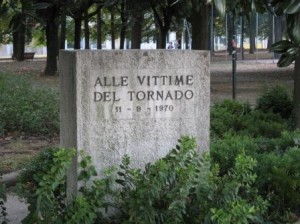
I haven’t applied myself to learning the story behind the monument to this catastrophe. A monument there certainly ought to be; this one is extremely unimpressive to the uninformed eye, but I can imagine that it might even be a piece of wreckage, so I won’t make any aesthetic judgments.
There it squats, in its little garden. The people who lived through this catastrophe remember perfectly well without it, and the people who didn’t quite possibly don’t even notice it.
Monuments are such curious creations. We need them, but then we get used to them and then eventually forget (or never know) their reason for being. I think they may be another form of burial rite, something like cairns or menhirs. In this case, it may be that this chunk of cement carries more meaning than anyone could even express.
(Photographs of the damage may be seen at http://www.musicain.it/VENEZIA/TORNADO.HTM. Portions of the eyewitness accounts have also been drawn from this document.)
Most of the journalism about Venice, either print or TV, points out tourism as Venice’s main defining characteristic, which is about as simple a discovery to make as that water fills the canals. Apparently the appeal is eternal to the average journalist and editor looking for a story which is immediately sensational and not at all hard to do. A story on tourism here practically writes and photographs itself.
In doing so the reporters universally bewail it, to one degree or another, in the same way one would bewail any uncontrollable natural disaster such as grasshopper swarms, tornadoes, avalanches. You’d almost think that tourists come to Venice deliberately to wreak havoc on an innocent, helpless, unsuspecting, undeserving victim. The lines in these stories are usually pretty clear: City Good, Tourist Bad.
Pictures of mass tourism at its most intense are the easiest images in the world to take, the journalistic equivalent of hitting the bull’s-eye from one foot away. Anybody can do it — I’ve done it myself. You don’t even have to open your eyes to take impressive pictures of the worst aspects of mass tourism. In fact it’s probably better if you don’t.
But there is much more to the situation than the simple outlines sketched by the just-passing-through journalists.
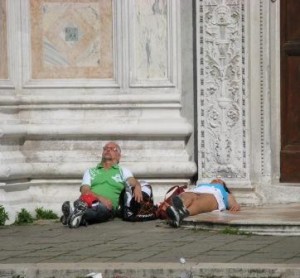
I am not defending the behavior of large segments of the mass tourist population. These are generically labeled “turisti da culo,” which literally means ass-tourists, but generally conveys a wide range of rude, thoughtless, generally sub-civilized behavior. There is never any lack of examples, especially in the summer. This race of tourist is horrifying, demoralizing, offensive, depressing. I could tell you stories. And yes, of course there are too many of them.
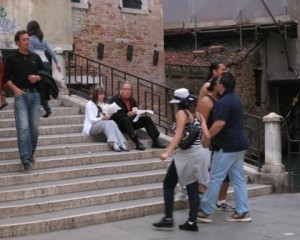
But I want to pause for a moment in mid-cliche’ to regard the situation from two important points of view which are rarely addressed as everyone is busy wailing and gnashing their teeth.
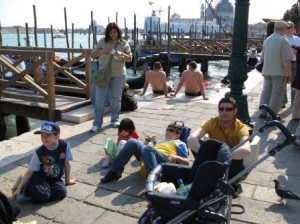
First, the city officials who have been assigned the role of City Councilor for Tourism over the years are politicians. They are not trained in the industry of tourism, an industry as demanding and complex as making steel or developing drugs. Further, it is the nature of the political breed to be cautious and easily swayed by conflicting demands, which makes planning, and then executing any plan, hugely difficult. And unappealing. Politicians on the whole tend to avoid “difficult” and “unappealing.” So a lot of tiny, disconnected actions are undertaken to minimize, if not solve, whatever is the most pressing problem of the moment.
The current Councilor for Tourism, a native Venetian lawyer named Augusto Salvadori, is famous for his impassioned oratory on behalf of his beloved city, the need to protect her and defend her and nourish and cherish her. It’s like the wedding vow. He is often on the verge of weeping before he finishes. People have come to expect it.
But he has no program, he has only little temporary fixettes. My favorite was the recent day to promote Decorum (yes, that’s the word they use for clean, tidy and polite), one of whose more publicized aspects was that the city offered to donate geraniums to anybody who wanted them, in order to brighten up the windowsills. If he had thought of donating the same number of large trash bins to be distributed far and wide to mitigate the incessant leaving of garbage on said windowsills because no alternative is to be found, the city wouldn’t need flowers in order to look better. You can walk from the vaporetto stop at San Pietro di Castello as far as the Bridge of the Veneta Marina (a straight shot of about 20 minutes, if you dawdle) without finding one (1) trash bin of any size whatsoever.
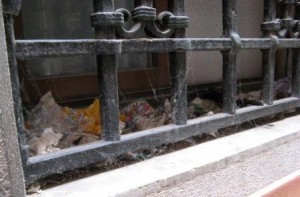
There aren’t many people who are willing to walk around town indefinitely with their empty soda can, beer bottle, or plastic ice-cream cup in their hand, searching for a place to dispose of it.
So: Point One is that the persons in charge of tourism here are unprepared for anything other than Making Suggestions. Which isn’t the same as Having Ideas.
Tourism is Venice’s only source of income. Yet it is inexplicably and profoundly — even stubbornly — even proudly, it sometimes seems — mishandled. The individuals charged with managing this important, complicated, potentially destructive resource could be compared to a person hired as director of a mercury mine whose previous job had been, say, as the Judges and Stewards Commissioner of the International Arabian Horse Association.
“We need some truly visionary people,” professor Fabio Carrera told me the other evening. “There’s no long-range thinking. It’s very short-range.” A few months ago there was tremendous blowing of trumpets and waving of banners to publicize “VeniceConnected,” the next big step in tourism management here: One-stop online booking. Carrera snorts. “All these ideas that were good maybe five years ago, like VeniceConnected online. We should be doing ten times better in the future. But they think ‘We’re innovating’ by doing this crap.”
The fact that there is chaos at the top naturally leads to chaos all the way down to the poor bastard trying to find a place in the shade to have some kind of lunch that won’t cost a fortune. Bathrooms — can’t find them. Open late, close early. Vaporettos — confusing. Signage — random and often homemade. 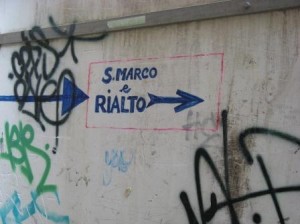 Street vendors — insistent and vaguely disturbing. Which leads to Point Two.
Street vendors — insistent and vaguely disturbing. Which leads to Point Two.
Point Two: Nobody ever takes the trouble to report on what is demanded of a tourist here. I see it every day and even as it repels me it also inspires something like pity. It must be the vacation equivalent of the Ranger Assessment Phase at Fort Benning, especially if you’ve got kids. I once stopped to help a family of three standing at the foot of a bridge with their eight suitcases (I counted them), unable to figure out where they were, much less how to get to their hotel. They had been standing there for a while.
Visiting Venice in the summer will almost certainly be hot, tiring, baffling, occasionally even upsetting, and it can cost far too much. A one-ride ticket on the vaporetto costing 6.50 euros ($9) is far too much. Two euros ($2.80) for a half-liter (two cups) bottle of water is far too much. Disposing of the result of the water you drank, if you avail yourself of one of the few but very clean municipal bathrooms costs 1.50 euros ($2), which is far too much. But cheaper than the original bottle of water, true.
I am not defending or excusing the type of tourist of which one sees way too many here: Oblivious, rude, loud, and often, yes, ugly. The garb, the behavior, the everything is impossible to defend. When people leave home, many evidently leave their manners at the kennel with the dog. (The fact that there can also be rude, loud, ugly Venetians is noted by the court, but doesn’t have any bearing on this case.) But to be a tourist here, enchanting as the city is, must be debilitating.
Still, that doesn’t explain why they have to shuffle around the narrow streets like wounded water buffalo, stopping with no warning and blocking your passage, or to ride the vaporetto with 60-pound packs on their backs, nonchalantly laying waste to everyone around them as they turn this way and that, admiring the view.
So let’s sum up the situation: The city puts up with aggravations and discourtesies and even damage, large and small, all day, every day, and also at night, but it gets money. And the tourist struggles around a bewildering, overloaded bunch of Baroque/Renaissance/Veneto-Byzantine-laden islands, but gets lots of pictures of canals and belltowers.
I don’t know. Something is definitely missing from these equations.